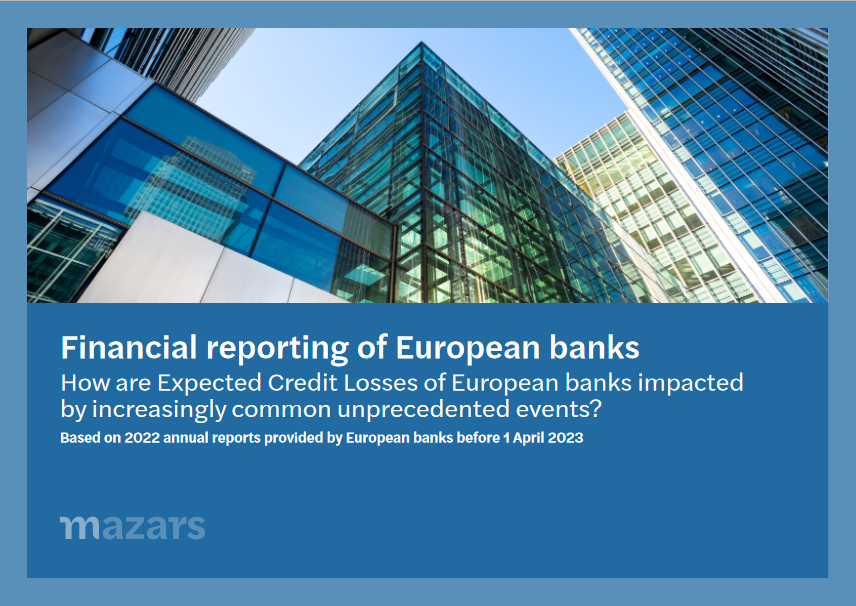The study was based on Mazars' analysis of the 2022 Annual Report & Accounts of 26 banks in 11 European countries, including the study of key indicators over the last three years.

- With regard to the main indicators, such as the volatility of the P&L associated with the variation in Expected Credit Losses, the use of overlays and the variation in stage 3 exposures, there have been significant regional trends over the last three years. This year, in comparison with the outlook of the respective regulators, Mazars identified differences in expectations between the eurozone and the UK, with the former being more conservative than the latter with regard to the indicators used in the forward-looking components of the impairment models.
- Since 2019, we have seen a series of unprecedented events, creating an increasingly challenging economic environment for European banks.
June 23, 2023Mazars, the international auditing, tax and consulting firm, has launched the sixth edition of its "Financial Reporting of European Banks" report. The work focuses on analyzing the level of Expected Credit Loss (ECL) of European banks in fiscal year 2022 and is based on the analysis of information published in the 2022 annual reports and accounts of 26 banks in 11 European countries, including the United Kingdom, France, Spain, Germany, Italy and the Netherlands.
Over the last three years, there has been an evolution in the distribution of credit exposure (gross amounts) between the different ECL stagings, with a significant overall decrease in stage 1 and 3 Expected Credit Losses and an increase in stage 2. The changes in the quantification of Expected Credit Losses show a clear and homogeneous trend, with a significant decrease in stage 3 in favor of stage 2 and, to a lesser extent, stage 1 exposures. This trend is particularly illustrated by Italian banks, which have seen a significant decrease in impairment in general, particularly in stage 3, as a result of their policies to deleverage non-performing loans (NPLs).
In addition, it can be noted that almost all banks that use the eurozone GDP growth rate in the adjustment of forward-looking of their expected loss models use growth estimates that are actually more conservative than the European Central Bank's projections for the next three years. On the contrary, all the banks that use the UK's GDP growth rate make more optimistic assumptions than the Bank of England itself.
The report also reveals that over the course of last year there were clear differences between UK banks, which strongly reduced the weight of their overlays in the quantification of expected credit losses (ECL) in the 2022 financial year, while French and Italian banks showed a greater tendency to increase the overlays considered in the quantification of expected credit losses, moving closer to the market average.
The report is designed to serve as a practical benchmarking tool, helping credit institutions to compare the impact of the macroeconomic environment on their business with their peers. Next year Mazars will conduct an additional study to re-analyze and understand how these developments have affected banks and their ECL levels.
 "Our new report highlights the impact of multiple unprecedented events in recent years on the performance of European banks. By providing financial institutions with benchmark information on key trends and key performance indicators related to expected credit losses, we hope to give them access to the most relevant information to help them understand where they stand in relation to their peers, both at a regional and European level. Mazars remains committed to supporting global banks in tackling the economic and political obstacles, as well as the regulatory challenges that the banking sector is currently facing," says Filipe Carvalho, Partner at Mazars in Portugal.
"Our new report highlights the impact of multiple unprecedented events in recent years on the performance of European banks. By providing financial institutions with benchmark information on key trends and key performance indicators related to expected credit losses, we hope to give them access to the most relevant information to help them understand where they stand in relation to their peers, both at a regional and European level. Mazars remains committed to supporting global banks in tackling the economic and political obstacles, as well as the regulatory challenges that the banking sector is currently facing," says Filipe Carvalho, Partner at Mazars in Portugal.
Main conclusions for the 2022 financial year compared to the 2021 financial year
- The average ratio of expected credit loss expenses divided by operating income before ECL expenses decreased to 17% in 2022 (20% in 2021).
- Although the trend at the end of the 2021 financial year pointed to an overall reduction in ECL charges (-81% between the end of the 2020 financial year and the end of the 2021 financial year), compared to the peak in additional impairment needs during the COVID-19 crisis, all the credit institutions in the sample have since returned to an increase in ECL (+106% between the end of the 2021 financial year and the end of the 2022 financial year).
Explore the decomposition of expected credit losses, forward-looking adjustments and the constitution of overlays in the models
The report covers a number of important topics, including:
- Impact of the ECL charge in 2022.
- Expected credit losses: changes in coverage ratios and distribution between the different stages.
- Adjustments to forward-looking and the existence of overlays in the models.
- Evaluation of some of the forward-looking information contained in the banks' annual reports.
Main conclusions on other topics
- In the 2022 financial year, three credit institutions in Mazars' sample reclassified financial assets due to a change in the business model during the reporting period (following the classification requirements of IFRS 9).
- All banks had liabilities from the third series of longer-term refinancing operations (TLTRO III) partially repaid early in 2022, with a range of 14% to -86% compared to the TLTRO III amounts on the 2021 balance sheet.
- Eight banks disclosed information on the accounting treatment applied to the modification of TLTRO III in October 2022 by the ECB.
- Most of the banks that disclosed this information treated the change as a "reset" of a variable interest rate with no impact on profits or losses.
##
Methodology
This study is based on the information disclosed in the annual reports and accounts of the participating banks, without taking into account any press releases, investor-oriented presentations or similar publications. Each bank is represented by an alphanumeric code consisting of two letters - for example FR for France - and a number. When the sample features only one bank from a country, to maintain anonymity, the country code is "O" for "Other Countries". To increase comparability, the Mazars selected relevant indicators disclosed by most of the banks in the sample. Therefore, when a bank does not appear in a chart, it means that it has not disclosed data relevant to that chart. Some indicators presented, such as the ECL coverage ratio, were calculated based on data from the annual reports. The detailed methodology for producing these figures is explained below.
Note to editors
Click here to access the full report

